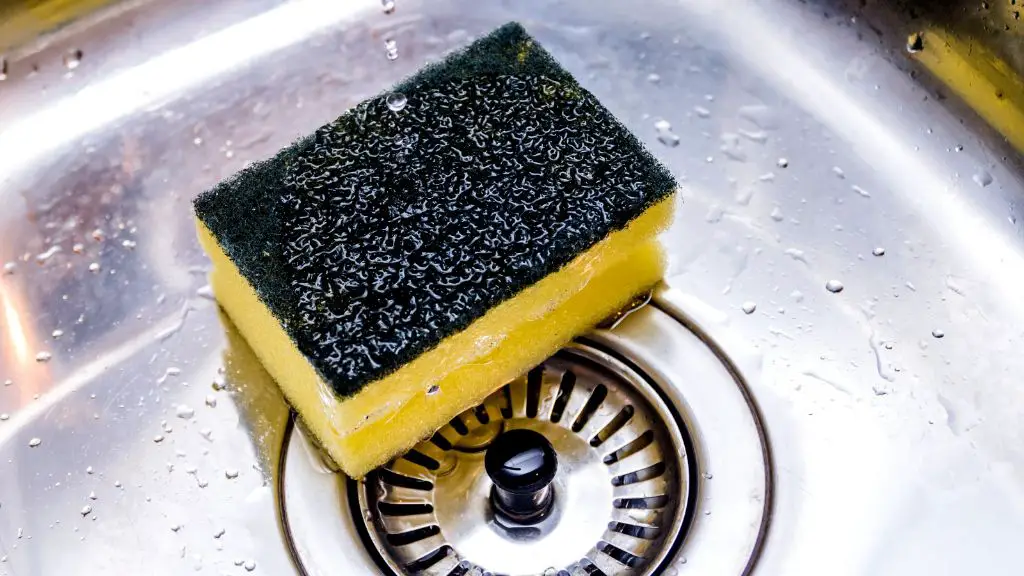Where Should A Kitchen Sponge Be Placed?
Where you place your kitchen sponge can have a big impact on hygiene and preventing the spread of bacteria. With kitchen sponges coming into frequent contact with dirty dishes, food particles, and bacteria, proper placement and care is essential.
In this article, we’ll examine common sponge placements like the countertop or in the sink, discuss best practices for optimal sponge hygiene, and provide a clear recommendation for the best place to keep your kitchen sponge.
Kitchen Sponge Hygiene
Kitchen sponges are breeding grounds for bacteria. Research shows that the moist environment of sponges allows for rapid bacterial growth. One study found over 54 billion bacterial cells per square inch in used kitchen sponges, with coliform counts up to 4 million CFU per square inch (Source). Salmonella, E. coli, and other potentially harmful bacteria thrive in used sponges.
Proper placement and regular replacement of kitchen sponges can help reduce bacterial growth. Storing sponges in dry areas and disinfecting them regularly are important practices. Replacing sponges every 1-2 weeks is recommended to limit bacterial buildup.
Common Sponge Placements
There are a few common places people store their kitchen sponges:
Countertop
Many people keep their sponge right on the countertop near the sink for easy access while washing dishes. However, this can lead to quick bacteria growth as the sponge sits damp between uses. Kitchen counters also collect lots of germs from food prep that can transfer back to the sponge [1].
In the Sink
Storing a sponge in the sink may keep it slightly more contained, but it still stays damp and can pick up whatever grime is in the sink. Water pools in the sink can contain microbes. Letting a sponge soak in the sink promotes bacterial growth [1].
Dishwasher
The heat and soap in a dishwasher can sanitize sponges between uses. Storing sponges in the top rack or utensil basket allows them to dry out more between washes. This helps limit bacteria growth compared to soaking in the sink [1].
Countertop Placement
Many people choose to place their kitchen sponge directly on the countertop when not in use. This is convenient since the sponge is visible and within easy reach for cleaning dishes or wiping up spills.
However, research shows that the countertop is one of the worst places to store a sponge due to contamination risks. According to a study published in the journal Scientific Reports, kitchen sponges left on a countertop quickly become breeding grounds for harmful bacteria. Within a week, the bacterial load on a countertop sponge can reach more than 10 million cells per square centimeter.
This rapid bacterial growth is likely due to the moist, nutrient-rich environment inside the sponge. Food particles, grease, and moisture get trapped in the sponge fibers. These provide an ideal habitat for bacteria to thrive, even at room temperature. Sitting on the counter exposes the sponge to air exchange which can further promote microbial growth.
For these reasons, while countertop storage is convenient, it comes at the cost of higher contamination risk. Placing used sponges on kitchen counters is not recommended from a food safety standpoint.
In the Sink
Some people choose to leave their kitchen sponge directly in the sink. This contains any water and food mess to the sink area. However, according to research, this is not the most hygienic practice.
Leaving a sponge in the sink allows it to stay wet for longer periods of time between uses. The moist environment promotes the growth of bacteria and mold. One study found that 70% of kitchen sponges analyzed contained coliform bacteria, likely transferred from raw meat and poultry. The continually damp sponge provides an ideal breeding ground for these harmful microbes to multiply quickly (Source).
So while keeping your sponge in the sink contains mess, the prolonged moisture exposes you to higher risks of cross-contamination and spreading foodborne illnesses. Experts recommend against leaving sponges directly in your sink for this reason.
Dishwasher Placement
Placing kitchen sponges in the dishwasher can be an effective way to sanitize and disinfect them. The high heat from the dishwasher can kill up to 99.9% of bacteria, viruses, and germs that have accumulated on the sponge (source: https://pubmed.ncbi.nlm.nih.gov/33152572/). The hot water and detergent also help to break down food particles, oils, and other debris trapped within the sponge. Additionally, the drying cycle of the dishwasher helps dry out the sponge which can further inhibit bacterial growth.
However, there are some downsides to placing sponges in the dishwasher. It takes up space that could otherwise be used for dishes and utensils. The sponge may also disintegrate faster with repeated dishwasher use. Proper loading is important so the sponge doesn’t obstruct the wash arms. It’s recommended to place the sponge on the top rack or in a utensil basket (source: https://www.cnn.com/2022/06/07/health/dish-washing-sponge-vs-brush-scn-wellness/index.html). Overall, the dishwasher can be an effective sanitizing method for sponges, with some minor drawbacks.
Other Options
In addition to common placements like the countertop or sink, there are other creative options for storing kitchen sponges:
Sponge holders or caddies can keep your sponge tidy and help it dry out between uses. Look for holders with ventilation or made of mesh to promote drying. Fun, decorative holders like this and this can brighten your kitchen. Place holders near the sink for easy access.
Microwaving sponges can kill bacteria and viruses. Wet the sponge then microwave for 1-2 minutes. This should be done daily. Replace sponges frequently, as microwaving does not kill all germs. Be cautious of fire risk when microwaving.
Best Practices
To maintain proper hygiene and reduce the risk of spreading germs, it’s important to follow best practices when using a kitchen sponge (CITATION: https://nymag.com/strategist/article/eco-friendly-sponge-alternatives.html). Here are some recommendations:
Replace monthly – Kitchen sponges easily collect bacteria, mold, and yeast. To prevent the growth of pathogens, replace sponges at least once per month (CITATION: https://theearthlingco.com/blogs/news/dish-sponge-alternative). Having multiple sponges on hand makes this easier.
Disinfect regularly – Sanitize sponges between uses by microwaving them for 1-2 minutes or soaking in a bleach solution. This will help kill some of the bacteria (CITATION: https://www.kempii.co.uk/blogs/cleaning/7-kitchen-sponge-alternatives).
Allow to dry thoroughly – Bacteria thrives in moist environments. Wring sponges out completely and allow to air dry between uses (CITATION: https://nymag.com/strategist/article/eco-friendly-sponge-alternatives.html). Don’t leave them sitting in water.
Recommendation
Based on the pros and cons of the various kitchen sponge placement options, the ideal recommendation is to keep the sponge completely separate from the sink. The best practice is to store the sponge on a tray or hook at least a few feet from the sink, and allow it to fully air dry between uses. Though convenient, leaving a sponge in or near the sink leads to excessive moisture and promotes rapid bacterial growth. Storing the sponge in a separate spot away from the sink helps preserve its cleanliness and minimize cross-contamination.
According to a 2020 study published in the Journal of Family Medicine and Primary Care, sponges left near the sink had higher bacteria counts and increased risk of spreading foodborne illnesses. Proper drying and storage away from moist areas is crucial for kitchen hygiene.

In summary, keeping the sponge completely separate from the sink in a designated storage spot is the ideal placement to balance convenience and proper hygiene.
Conclusion
The best place for a kitchen sponge, based on hygiene and convenience, is on the countertop, away from the sink and other wet areas. A countertop sponge holder allows the sponge to dry out between uses, preventing bacterial growth. At the same time, a countertop sponge is readily accessible for cleaning tasks. Other placements like in the sink or dishwasher can negatively impact the sponge’s longevity and cleanliness. To maximize hygiene, kitchen sponges should be replaced frequently, about once a week. With proper placement and replacement, kitchen sponges can be used safely and effectively for daily cleaning.



